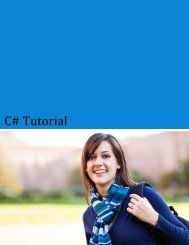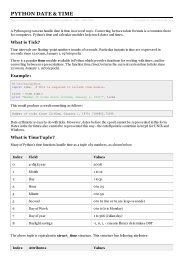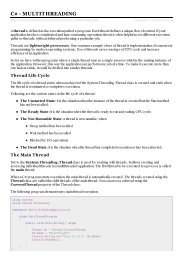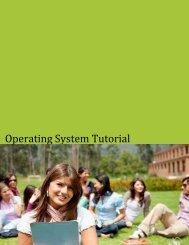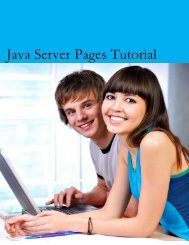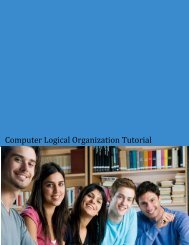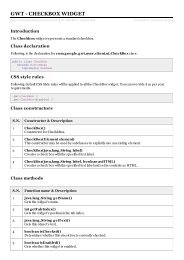download pl/sql tutorial (pdf - Tutorials Point
download pl/sql tutorial (pdf - Tutorials Point
download pl/sql tutorial (pdf - Tutorials Point
You also want an ePaper? Increase the reach of your titles
YUMPU automatically turns print PDFs into web optimized ePapers that Google loves.
CHAPTER<br />
3<br />
Basic Syntax<br />
This chapter describes the basic syntax followed:<br />
PL/SQL is a block-structured language, meaning that PL/SQL programs are divided and<br />
written in logical blocks of code. Each block consists of three sub-parts:<br />
S.N. Sections & Description<br />
1<br />
2<br />
3<br />
Declarations<br />
This section starts with the keyword DECLARE. It is an optional section and defines all<br />
variables, cursors, subprograms, and other elements to be used in the program.<br />
Executable Commands<br />
This section is enclosed between the keywords BEGIN and END and it is a mandatory<br />
section. It consists of the executable PL/SQL statements of the program. It should have at<br />
least one executable line of code, which may be just a NULL command to indicate that<br />
nothing should be executed.<br />
Exception Handling<br />
This section starts with the keyword EXCEPTION. This section is again optional and<br />
contains exception(s) that handle errors in the program.<br />
Every PL/SQL statement ends with a semicolon (;). PL/SQL blocks can be nested within other<br />
PL/SQL blocks using BEGIN and END. Here is the basic structure of a PL/SQL block:<br />
DECLARE<br />
<br />
BEGIN<br />
<br />
EXCEPTION<br />
<br />
END;<br />
The 'Hello World' Exam<strong>pl</strong>e:<br />
DECLARE<br />
message varchar2(20):= 'Hello, World!';<br />
BEGIN<br />
dbms_output.put_line(message);<br />
TUTORIALSPOINT<br />
Sim<strong>pl</strong>y Easy Learning Page 13




